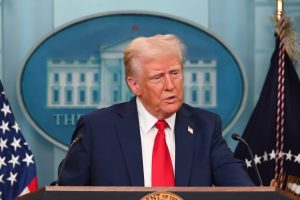U.S. President Donald J. Trump returned to the White House to begin his second term in office in January. As in his first term, Trump quickly reaffirmed his identity as the self-proclaimed “Tariff Man,” this time almost immediately announcing a series of tariff policies as part of the “America First” strategy embodied in his “Make America Great Again” or “MAGA” slogan.
On February 1, Trump signed an executive order imposing 25 percent tariffs on imports from Canada and Mexico. On the same day, he announced he would be instituting a 10 percent additional tariff on imports from China. On February 27, he announced a policy of imposing 25 percent tariffs on the European Union, ostensibly a U.S. ally. By product line, 25 percent tariffs were imposed on all steel and aluminum imports on February 10. Trump threatens to impose tariffs, including reciprocal tariffs, on most of America’s trading partners, regardless of whether they are allies or not.
In a shift from what we have seen in recent years, the United States is now replacing China as the main proponent of economic statecraft, using economic tools to exercise influence over other countries and attain diplomatic objectives. The U.S. claims that the purpose of its tariff policy is to correct unbalanced trade and bolster national security. Although many economists have expressed concerns that the tariffs will accelerate domestic inflation and trigger international turmoil and a global economic downturn, the Trump administration appears certain to ignite a tariff war.
ASEAN next?
Although Washington has not announced individual tariff measures targeting ASEAN member states, it appears only a matter of time before it turns its eyes to the region. Looking at America’s trade deficits by country in 2024, China (295.4 billion dollars) and Mexico were followed by Vietnam (123.5 billion dollars), while Thailand was at a number eleven (45.6 billion dollars). America’s overall trade deficit with ASEAN was 230.5 billion dollars, putting the bloc second behind only China. It is unlikely that the Trump administration will leave these nations untouched.
In the past, the United States have identified countries with whom it was running trade deficits as “currency manipulators” and imposed sanctions. According to the U.S. Treasury Department, there are three criteria for a determination of a currency manipulator: an trade surplus with the U.S. of more than 20.0 billion dollars; a current account surplus of more than 3 percent of GDPcontinuous and one-sided intervention in the foreign exchange market.
Countries that meet two of these criteria are placed on the Treasury’s monitoring list, while any country that meets all three is considered a currency manipulator and becomes subject to monitoring and possible tariff hikes and financial sanctions.
Now the Trump administration is bypassing this process entirely, and imposing tariffs directly on trade partners with whom the U.S. runs trade deficits. As such, ASEAN nations could be subject to tariffs at any time.
Trump’s approach to diplomacy is fundamentally transactional in nature. When a counterparty sits at the negotiation table, what cards they hold becomes extremely important. This was illustrated recently during Trump’s meeting with Ukrainian President Volodymyr Zelensky, when the U.S. president said, “You’re not in a good position. You don’t have the cards right now. With us, you start having cards.” Japan’s Minister of Economy, Trade and Industry Yoji Muto meanwhile experienced this reality for himself on his recent visit to America, when he sought an exemption from Trump’s steel and aluminum tariffs, only to return home empty handed.
Consequently, before entering into negotiations with Trump’s America, you need to know what cards you actually hold and think about how you might use them.
Among ASEAN nations, Thailand holds a powerful card, namely the 1966 Treaty of Amity and Economic Relations. Under the Treaty, Thailand granted only American citizens and entities national treatment in investment, allowing U.S. companies to take majority stakes in most industry sectors where foreign capital investment is otherwise restricted.
When Thailand became a member of the World Trade Organization in 1995, it pledged that it would meet the “Most Favored Nation” requirements after 10 years (meaning that the privileges granted to U.S. entities would be phased out after that period). In fact, the treaty has not been abolished, and American entities still receive special treatment.
In the Cold War era, the United States positioned Thailand as an important strategic partner in Southeast Asia and stepped up its economic cooperation. During the Vietnam War, Thailand housed military bases for the U.S. and played the role of a supply point; the treaty was concluded in return for this contribution.
Later, Thailand changed its overall foreign investment policy to become more selective. Under the 1972 Alien Business Law, the market entry of foreign entities was severely restricted. Although the regulations were eased somewhat with the 2000 Revised Foreign Business Act, rigid restrictions are still in place, particularly in the non-manufacturing sector.
If the U.S. wishes to keep the Treaty of Amity and Economic Relations in place, Thailand could seek to incorporate its content into a free trade agreement (FTA). Although the Trump administration is not a fan of FTAs, if Thailand were to be successful in beginning FTA negotiations, it would dramatically improve its ability to attract investment.
Will Thailand use this card to deflect tariffs – or to unlock FTA negotiations? Whatever the case, it is essential that ASEAN nations have clear strategies for negotiations with the United States. With a global tariff war looming, ASEAN must now identify exactly what cards it holds—and how best to play them.
SUKEGAWA Seiya is a professor at the Faculty of Political Science and Economics, Kokushikan University, and a visiting professor at Thai-Nichi Institute of Technology.
































